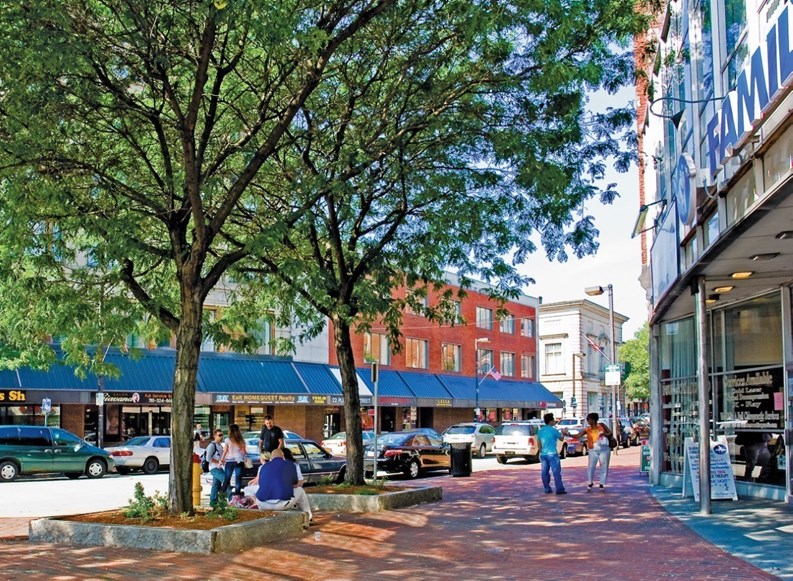When people mention “suburbs,” it’s not uncommon to think of quiet towns – bedroom communities – lacking the vibrancy of the nearby city that residents head off to each morning. Malden, Massachusetts, however, though only a 12-minute train commute from downtown Boston, is defying that stereotype. “Malden,” says Mayor Richard C. Howard, “is a city of opportunities” working to beautify and improve itself. Thanks in part to his long-term mayoral leadership, the city is succeeding in doing just that, particularly in the areas of schooling and housing.
The River’s Edge
Industry in Malden had peaked as late as the 1920s and ’30s, thanks to the help of various immigrant communities. By the 1950s, however, industries were shifting, and many of the immigrant communities who had helped build the city up in earlier decades began to move out. Malden began to sink into obscurity. Even its river, named after the city and vital to its industrial heyday, was almost forgottenin a thicket of overgrowth and debris.
Then in the 1990s, when it seemed the river and the city might disappear altogether, an inspiration was born. Malden and two of its neighboring towns, Everett and Medway – in spite of long-standing competition in business and sports –began to discuss a collaborative effort to regenerate the former industrial area along the river.
Enter Preotle, Lane and Associates, a visionary New York-based development company that was determined to truly revive the area for the good ofthe community, rather than attempt another run-of-the-mill office park. After years of clean-up and red tape, the cities and developers have finally gotten their enterprise, appropriately named “River’s Edge,” underway.
Impressive in scope and in detail, the 30-acre mixed-use venture has now completed the first of three phases. The first phase includes a 10-acre park, three office buildings and a luxury residence with over 220 units, 15 of which are “affordably priced,” according to the City of Malden. The park is already open to the public from 7 a.m. to 5 p.m. each day, with fully accessible walking paths throughout. The residences are slated to open this year. Only minutes away from Wellington MBTA Station, the complex provides easy access to Boston and surroundingcities. The project, with two more phases to go, has already received significant awards: the Honor Design Award from Boston Society of Land-scape Architects, for Reclamation and Conservation, and the LEED Gold Pre-certification given by the U.S. Green Building Council (USGBC).
You don’t have to live and work at River’s Edge, however, to experience all that Malden has to offer. At the very least, the city is easy to get to. Both Oak Grove MBTA station and Malden Center Station make travel to and from Boston quick and uncomplicated. In fact, from Malden Center Station, you can even commute from New Hampshire if you need to. The city is also reachable by Route 1 and Interstate 93, and is served by a fleet of buses.
While traveling from Malden to its surrounds and back again is certainly straightforward, loyal residents might assert that it is unnecessary. New restaurants, cafes, bars and clubs have been opening in the city precincts. Some of the eateries have received glowing reports from such noteworthy critics as the Phantom Gourmet. According to the Boston Phoenix, Malden is considered an up-and-coming “hotspot.” Residents are also proud of their schools (particularly five new, technology-infused K-8 schools which have opened since 1999), proudof their recreational centers, proud of their location and proud of the small-town feel they maintain in spite of being legally recognized as a city.
Adjusting with the Current
The city of Malden itself encompasses only five square miles. Within those five miles, however, is a lot of neighborhood. The city is divided into eight wards and distinct neighborhoods, suchas Linden, Edgeworth, the West End and Oak Grove. Each neighborhood has its own personality and characteristics, and each ward holds its own annual Fourth of July celebration.
Celebration of its residents, both past and present, seems to mark the city. Malden’s Bell Rock Memorial Park contains a memorial to the veterans of World War II who lived in Malden’s Ward One. Now the city’s leaders are constructing a new memorial for that war’s veterans, one that recognizes all Malden residents who were drafted or enlisted while living in the city. “Rightnow we have a list of 9,600 names that we are editing and tweaking,” says Deborah Burke, Malden’s Project Director for Economic Development. She says they hope to have the monument completed by the hundredth anniversary of the park, which occurs in 2010.
Meanwhile, current residents can take full advantage of what Burke calls “outstanding recreational amenities.” These, she notes, include three synthetic turf fields, the Fellsmere Pond and a synthetic running track at Macdonald Stadium. There is also a recreational ice skating rink downtown, used not only by the general public, but also by the city of Malden’s and Tufts University’s ice hockey teams. In 2005, the Malden YMCA, which held the distinction of being the fourth oldest Y in the country, was replaced by a new, state-of-the-art YMCA. It contains two pools, a gym and a walking track, and day care and after school programsare available.
During-school programs are also important to Maldonians. Not only does Malden boast the five new technology-infused schools for grades K-8, but it offers a choice of three high schools: Malden High School, Malden Catholic High School and the Mystic Valley Regional Charter High School. According to Burke, “Malden High School in November 2008 was named one of the best public high schools in the state.” And in the past two years it also has graduated more “Posse Scholars” (typically low-income kids from families without previous college grads) than any high school in the Commonwealth, including Boston Latin School.
Housing a Bright Spot
Besides improved schools, another bright spot in Malden is certainly its housing. Decent, affordable housing is a high priority. Not only is the city being redefined by projects like River’s Edge, but Burke says the Malden Redevelopment Authority “offers low-interest rehab loans and mortgages to first and second time home-buyers in the city.” The style of housing in Malden runs the gamut of Victorian homes, post-war housing, and new condominiums. In June 2008, the Boston Globeaffirmed Malden as an excellent place for starter homes and renovators. Burke adds that owner-occupants within Malden can qualify for a residential tax exemption.
Malden doesn’t just offer incentives for buyers and owners residing in the city, however. The city of Malden and its Redevelopment Authority run a Housing Task Force which Burke describes, as its mission to “track blighted properties and take action in a proactive way to correct issues.”
One of these creative housing initiatives is the Irving Street Studios. This is a 1920s former convent which, thanks to the Redevelopment Authority, has been reconfigured into housing specifically for the artist community. The units are compact but efficiently designed for space, lighting, and energy saving. Some of the living units are connected to studios; other studios arelocated separately, but each artist gets his or her own space to work. There are also common areas, serving to make the Irving Street Studios a true community. Artists are drawn to Malden because of its small-town feel and the ability to contribute to the vibrant art scene in Boston.
Robert Donnelly, the city’s tax assessor, says there are 5,597 single-family homes in Malden, and 1,994 condominium units. In the last six months of 2009, he says, 76 single family homes have sold, at an average price of $256,628, slightly higher than the average listing price. At the same time, 48 condominium units have sold, averaging $206,823. This price is somewhat under the average listing price. The more significant condo developments in the city include Daniels School, Briar Hill, Ledgewood Estates and Malden Place, with the number of units in these developments ranging from 104 to 142. Mayor Howard adds that real estate values have climbed 10 percent in the last half of 2009, which he regards as an encouraging sign to anyone hoping to invest in the area.
In spite of the nation’s struggling economy, Malden’s future looks anything but bleak. Officials and residents seem united in their efforts and desire to ensure that their city is a welcomingone for a long time to come. Sources agree that Maldonians most relish their city’s accessibility to the larger city proper while retaining a sense of neighborhood and community within. With that in mind, they are building toward the future, investing in the community around them and welcoming others into the city that is moving from the sidelines to the mainstream.
Jennifer Grosser is a freelance writer and a frequent contributor to New England Condominium magazine.







Leave a Comment